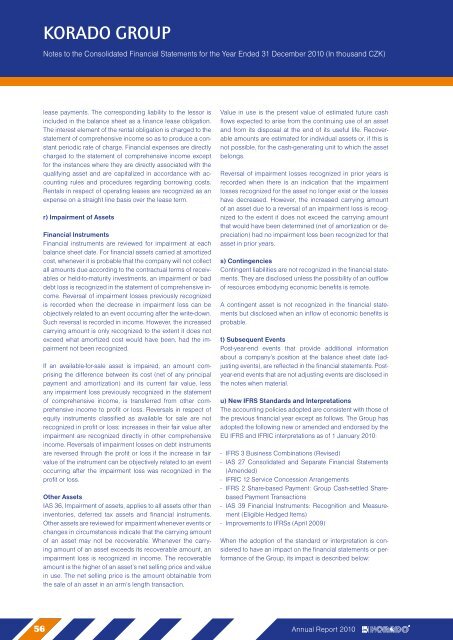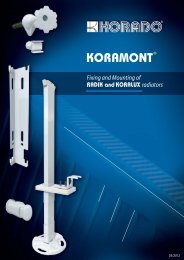ANNUAL REPORT - KORADO, as
ANNUAL REPORT - KORADO, as
ANNUAL REPORT - KORADO, as
You also want an ePaper? Increase the reach of your titles
YUMPU automatically turns print PDFs into web optimized ePapers that Google loves.
56<br />
<strong>KORADO</strong> GROUP<br />
Notes to the Consolidated Financial Statements for the Year Ended 31 December 2010 (In thousand CZK)<br />
le<strong>as</strong>e payments. The corresponding liability to the lessor is<br />
included in the balance sheet <strong>as</strong> a finance le<strong>as</strong>e obligation.<br />
The interest element of the rental obligation is charged to the<br />
statement of comprehensive income so <strong>as</strong> to produce a constant<br />
periodic rate of charge. Financial expenses are directly<br />
charged to the statement of comprehensive income except<br />
for the instances where they are directly <strong>as</strong>sociated with the<br />
qualifying <strong>as</strong>set and are capitalized in accordance with accounting<br />
rules and procedures regarding borrowing costs.<br />
Rentals in respect of operating le<strong>as</strong>es are recognized <strong>as</strong> an<br />
expense on a straight line b<strong>as</strong>is over the le<strong>as</strong>e term.<br />
r) Impairment of Assets<br />
Financial Instruments<br />
Financial instruments are reviewed for impairment at each<br />
balance sheet date. For financial <strong>as</strong>sets carried at amortized<br />
cost, whenever it is probable that the company will not collect<br />
all amounts due according to the contractual terms of receivables<br />
or held-to-maturity investments, an impairment or bad<br />
debt loss is recognized in the statement of comprehensive income.<br />
Reversal of impairment losses previously recognized<br />
is recorded when the decre<strong>as</strong>e in impairment loss can be<br />
objectively related to an event occurring after the write-down.<br />
Such reversal is recorded in income. However, the incre<strong>as</strong>ed<br />
carrying amount is only recognized to the extent it does not<br />
exceed what amortized cost would have been, had the impairment<br />
not been recognized.<br />
If an available-for-sale <strong>as</strong>set is impaired, an amount comprising<br />
the difference between its cost (net of any principal<br />
payment and amortization) and its current fair value, less<br />
any impairment loss previously recognized in the statement<br />
of comprehensive income, is transferred from other comprehensive<br />
income to profit or loss. Reversals in respect of<br />
equity instruments cl<strong>as</strong>sified <strong>as</strong> available for sale are not<br />
recognized in profit or loss; incre<strong>as</strong>es in their fair value after<br />
impairment are recognized directly in other comprehensive<br />
income. Reversals of impairment losses on debt instruments<br />
are reversed through the profit or loss if the incre<strong>as</strong>e in fair<br />
value of the instrument can be objectively related to an event<br />
occurring after the impairment loss w<strong>as</strong> recognized in the<br />
profit or loss.<br />
Other Assets<br />
IAS 36, Impairment of <strong>as</strong>sets, applies to all <strong>as</strong>sets other than<br />
inventories, deferred tax <strong>as</strong>sets and financial instruments.<br />
Other <strong>as</strong>sets are reviewed for impairment whenever events or<br />
changes in circumstances indicate that the carrying amount<br />
of an <strong>as</strong>set may not be recoverable. Whenever the carrying<br />
amount of an <strong>as</strong>set exceeds its recoverable amount, an<br />
impairment loss is recognized in income. The recoverable<br />
amount is the higher of an <strong>as</strong>set’s net selling price and value<br />
in use. The net selling price is the amount obtainable from<br />
the sale of an <strong>as</strong>set in an arm’s length transaction.<br />
Value in use is the present value of estimated future c<strong>as</strong>h<br />
flows expected to arise from the continuing use of an <strong>as</strong>set<br />
and from its disposal at the end of its useful life. Recoverable<br />
amounts are estimated for individual <strong>as</strong>sets or, if this is<br />
not possible, for the c<strong>as</strong>h-generating unit to which the <strong>as</strong>set<br />
belongs.<br />
Reversal of impairment losses recognized in prior years is<br />
recorded when there is an indication that the impairment<br />
losses recognized for the <strong>as</strong>set no longer exist or the losses<br />
have decre<strong>as</strong>ed. However, the incre<strong>as</strong>ed carrying amount<br />
of an <strong>as</strong>set due to a reversal of an impairment loss is recognized<br />
to the extent it does not exceed the carrying amount<br />
that would have been determined (net of amortization or depreciation)<br />
had no impairment loss been recognized for that<br />
<strong>as</strong>set in prior years.<br />
s) Contingencies<br />
Contingent liabilities are not recognized in the financial statements.<br />
They are disclosed unless the possibility of an outflow<br />
of resources embodying economic benefits is remote.<br />
A contingent <strong>as</strong>set is not recognized in the financial statements<br />
but disclosed when an inflow of economic benefits is<br />
probable.<br />
t) Subsequent Events<br />
Post-year-end events that provide additional information<br />
about a company’s position at the balance sheet date (adjusting<br />
events), are reflected in the financial statements. Postyear-end<br />
events that are not adjusting events are disclosed in<br />
the notes when material.<br />
u) New IFRS Standards and Interpretations<br />
The accounting policies adopted are consistent with those of<br />
the previous financial year except <strong>as</strong> follows. The Group h<strong>as</strong><br />
adopted the following new or amended and endorsed by the<br />
EU IFRS and IFRIC interpretations <strong>as</strong> of 1 January 2010:<br />
- IFRS 3 Business Combinations (Revised)<br />
- IAS 27 Consolidated and Separate Financial Statements<br />
(Amended)<br />
- IFRIC 12 Service Concession Arrangements<br />
- IFRS 2 Share-b<strong>as</strong>ed Payment: Group C<strong>as</strong>h-settled Shareb<strong>as</strong>ed<br />
Payment Transactions<br />
- IAS 39 Financial Instruments: Recognition and Me<strong>as</strong>urement<br />
(Eligible Hedged Items)<br />
- Improvements to IFRSs (April 2009)<br />
When the adoption of the standard or interpretation is considered<br />
to have an impact on the financial statements or performance<br />
of the Group, its impact is described below:<br />
Annual Report 2010





